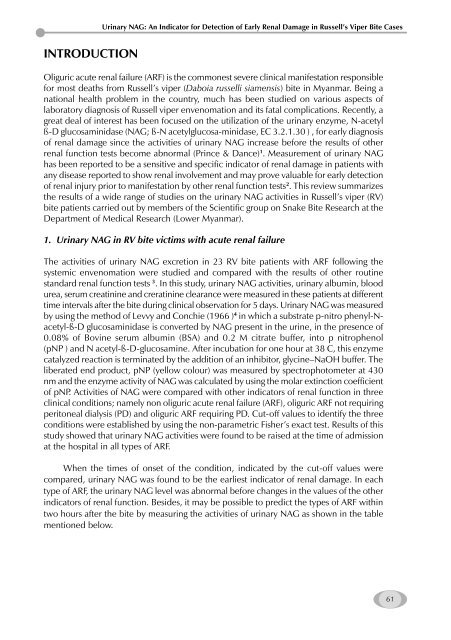Management of Snakebite and Research Management of Snakebite ...
Management of Snakebite and Research Management of Snakebite ...
Management of Snakebite and Research Management of Snakebite ...
Create successful ePaper yourself
Turn your PDF publications into a flip-book with our unique Google optimized e-Paper software.
INTRODUCTION<br />
Urinary NAG: An Indicator for Detection <strong>of</strong> Early Renal Damage in Russell’s Viper Bite Cases<br />
Oliguric acute renal failure (ARF) is the commonest severe clinical manifestation responsible<br />
for most deaths from Russell’s viper (Daboia russelli siamensis) bite in Myanmar. Being a<br />
national health problem in the country, much has been studied on various aspects <strong>of</strong><br />
laboratory diagnosis <strong>of</strong> Russell viper envenomation <strong>and</strong> its fatal complications. Recently, a<br />
great deal <strong>of</strong> interest has been focused on the utilization <strong>of</strong> the urinary enzyme, N-acetyl<br />
ß-D glucosaminidase (NAG; ß-N acetylglucosa-minidase, EC 3.2.1.30 ) , for early diagnosis<br />
<strong>of</strong> renal damage since the activities <strong>of</strong> urinary NAG increase before the results <strong>of</strong> other<br />
renal function tests become abnormal (Prince & Dance) 1 . Measurement <strong>of</strong> urinary NAG<br />
has been reported to be a sensitive <strong>and</strong> specific indicator <strong>of</strong> renal damage in patients with<br />
any disease reported to show renal involvement <strong>and</strong> may prove valuable for early detection<br />
<strong>of</strong> renal injury prior to manifestation by other renal function tests 2 . This review summarizes<br />
the results <strong>of</strong> a wide range <strong>of</strong> studies on the urinary NAG activities in Russell’s viper (RV)<br />
bite patients carried out by members <strong>of</strong> the Scientific group on Snake Bite <strong>Research</strong> at the<br />
Department <strong>of</strong> Medical <strong>Research</strong> (Lower Myanmar).<br />
1. Urinary NAG in RV bite victims with acute renal failure<br />
The activities <strong>of</strong> urinary NAG excretion in 23 RV bite patients with ARF following the<br />
systemic envenomation were studied <strong>and</strong> compared with the results <strong>of</strong> other routine<br />
st<strong>and</strong>ard renal function tests 3 . In this study, urinary NAG activities, urinary albumin, blood<br />
urea, serum creatinine <strong>and</strong> creratinine clearance were measured in these patients at different<br />
time intervals after the bite during clinical observation for 5 days. Urinary NAG was measured<br />
by using the method <strong>of</strong> Levvy <strong>and</strong> Conchie (1966 ) 4 in which a substrate p-nitro phenyl-Nacetyl-ß-D<br />
glucosaminidase is converted by NAG present in the urine, in the presence <strong>of</strong><br />
0.08% <strong>of</strong> Bovine serum albumin (BSA) <strong>and</strong> 0.2 M citrate buffer, into p nitrophenol<br />
(pNP ) <strong>and</strong> N acetyl-ß-D-glucosamine. After incubation for one hour at 38 C, this enzyme<br />
catalyzed reaction is terminated by the addition <strong>of</strong> an inhibitor, glycine–NaOH buffer. The<br />
liberated end product, pNP (yellow colour) was measured by spectrophotometer at 430<br />
nm <strong>and</strong> the enzyme activity <strong>of</strong> NAG was calculated by using the molar extinction coefficient<br />
<strong>of</strong> pNP. Activities <strong>of</strong> NAG were compared with other indicators <strong>of</strong> renal function in three<br />
clinical conditions; namely non oliguric acute renal failure (ARF), oliguric ARF not requiring<br />
peritoneal dialysis (PD) <strong>and</strong> oliguric ARF requiring PD. Cut-<strong>of</strong>f values to identify the three<br />
conditions were established by using the non-parametric Fisher’s exact test. Results <strong>of</strong> this<br />
study showed that urinary NAG activities were found to be raised at the time <strong>of</strong> admission<br />
at the hospital in all types <strong>of</strong> ARF.<br />
When the times <strong>of</strong> onset <strong>of</strong> the condition, indicated by the cut-<strong>of</strong>f values were<br />
compared, urinary NAG was found to be the earliest indicator <strong>of</strong> renal damage. In each<br />
type <strong>of</strong> ARF, the urinary NAG level was abnormal before changes in the values <strong>of</strong> the other<br />
indicators <strong>of</strong> renal function. Besides, it may be possible to predict the types <strong>of</strong> ARF within<br />
two hours after the bite by measuring the activities <strong>of</strong> urinary NAG as shown in the table<br />
mentioned below.<br />
61









